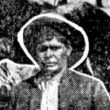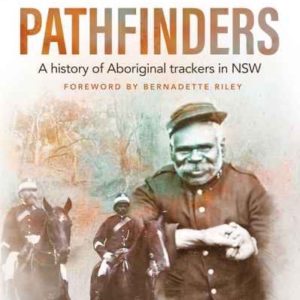Loading map...

In 1862, police from the new amalgamated force were stationed at the new stone Court House and lock-up in Macquarie Street. A new station and lock-up were constructed in Brisbane Street in the early 1870s. Police barracks were constructed on Erskine Street in 1877 along with stables and quarters for the tracker. The police paddock was nearby at the northern...
Learn More ►Information about Monty Tickle’s origins are sketchy, but according to his death certificate he was born in about 1900 at Cloncurry, Queensland, to Friday Tickle and Topsy. It is not known when he came to NSW, but by 1921 he was the tracker at Orange in the central-west of NSW. In August of that year he investigated the illegal slaughter...
Learn More ►Trackers were employed at Byrock Police Station from 1884 to at least 1938. The career of the first Byrock tracker, Jack Todhunter, was tragically short. He contracted typhoid fever two months after starting the job. He was transferred to Dubbo Hospital when his condition deteriorated and he passed away there on 10 March 1885. Little is known about Todhunter. He...
Learn More ►Charlie Hammond, son of Charlie Hammond Snr and Maria, was born on Wiradjuri country at Goolagong near Forbes in the 1870s. He was the tracker at Dubbo in 1902 and 1903. In May 1903 he helped arrest a man suspected of burning down a shed at Spicer's Creek to the east of Dubbo. The suspect's boots matched the prints at...
Learn More ►Working at Mount McDonald from June 1882 until the end of 1884, Tommy Pearce’s career is unusual in that it provides evidence that trackers sometime took a holiday. On Friday 27 April 1883, he passed through Carcoar “en route” to Dubbo for a “leave of absence”. The purpose of his trip or why the destination was Dubbo – perhaps he...
Learn More ►Billy Dargin was born on the Bogan River in about 1843. Nothing is known about his parents, but it was recorded at the time of his death in 1865 that he obtained his surname through working for Peter Dargin, a squatter who owned land in the Bathurst district and further west. Dargin is common Aboriginal surname from the Bogan River...
Learn More ►James Nerang, or Jimmy as he was often known, worked as a tracker in the central-west of NSW around the turn of the 20th century. He took a prominent part in tracking Jimmy and Joe Governor after the massacre at Breelong in 1900. He was stationed at Dubbo in January 1902 when he gave evidence identifying Charles Ryan, an Aboriginal...
Learn More ►Molong Police Station The only recorded tracker at Molong was Tommy who worked from 1883 to 1886. Nothing more about his life is currently known and trackers were not stationed at Molong after he left. A 20th century tracker with a link to Molong was Robert Henry Robinson who worked at Coonamble and Dubbo. His grandmother was Kitty Hanley, who,...
Learn More ►A single mounted policeman was first stationed at Dandaloo on the Bogan River in May 1871, rising to two early in the New Year. Trackers were employed from 1875 and through to 1909. Paddy was a well-traveled tracker who worked at Dubbo and Dandaloo in these early years. Prior to his employment he had been arrested and tried in October...
Learn More ►Trackers were employed at Parkes from as early as 1875 when two were sent to a nearby property to search for a lost boy. They returned five days later without success [ref]Sydney Mail and New South Wales Advertiser 2 October 1875: 425.[/ref]. The names of the trackers who worked from 1883 to 1886 are known. Alfred was the tracker in...
Learn More ►The police station at Obley, a rough bush structure, was first built in 1866 and staffed by two mounted constables and an unnamed tracker [ref]Medley, Coleen: Obley on the Little River.[/ref]. In December, the tracker successfully pursued James Auberry who was wanted for stealing sheep and fleeces from a number of local properties including Balderogery, Rocky Ponds and Yullundry [ref]NSW...
Learn More ►Billy Bogan, also known as William Field, was born on the Bogan River to the north of Nyngan in 1862, possibly at Billybingbone, another name he was known by. Employed as a tracker at Warren in 1882, he witnessed Charles Robertson stealing forage from the police station. Robertson was released on bail and he soon attempted to bribe Bogan with...
Learn More ►Cobbora is located on the Talbragar River about 80km east of Dubbo. Once a thriving agricultural and mining community, a police station was established in the town in the late 19th century. Trackers were employed at Cobbora from 1885 to 1896 including Tommy (1885-1894), Charley (1895-1896) and James Gillis McDonald (who tracked Jimmy and Joe Governor). Now privately owned, the...
Learn More ►A contemporary of Alex Riley, Frank Williams was a tracker who also received numerous accolades throughout his career. Williams was born in the country between Gundabooka and Toorale in the 1870s to Edward Williams and an Aboriginal woman named Fanny Hippi. He is associated with the Ngemba speaking peoples south of Bourke. After working as a labourer, he was appointed...
Learn More ►Perhaps the best known tracker in NSW is Alexander (or Alec) Riley, who worked, mainly at Dubbo, from 1911 to 1950. His tracking feats were respected by the white and Aboriginal communities, and in 1943 he was awarded the King’s Police and Fire Services Medal for Distinguished conduct. He was also the first tracker to be promoted to the rank...
Learn More ►
 This website explores the history of Aboriginal trackers in NSW from 1862 when the current NSW Police Force was established through to 1973 when the last tracker, Norman Walford, retired. You can read about the lives of individual trackers and some of the incredible tracking feats they...
This website explores the history of Aboriginal trackers in NSW from 1862 when the current NSW Police Force was established through to 1973 when the last tracker, Norman Walford, retired. You can read about the lives of individual trackers and some of the incredible tracking feats they...

There were over 200 NSW police stations that employed Aboriginal trackers between 1862 and 1973. Many were concentrated in the central-west and north-west of the state, the agricultural and pastoral heartland of NSW. This is because one of the main jobs of trackers was to pursue sheep, cattle and horse thieves. Trackers sometimes lived in small huts out the back...
Learn More ►
Pathfinders book Pathfinders, A history of Aboriginal trackers in NSW, written by Dr Michael Bennett and published by NewSouth, is now available from all good bookstores. Click on the link below to order your copy. https://www.abbeys.com.au/book/pathfinders-a-history-of-aboriginal-trackers-in-nsw.do Early History Since the beginning of the colony, government agencies, explorers, surveyors and members of the general public called upon the tracking...
Learn More ►